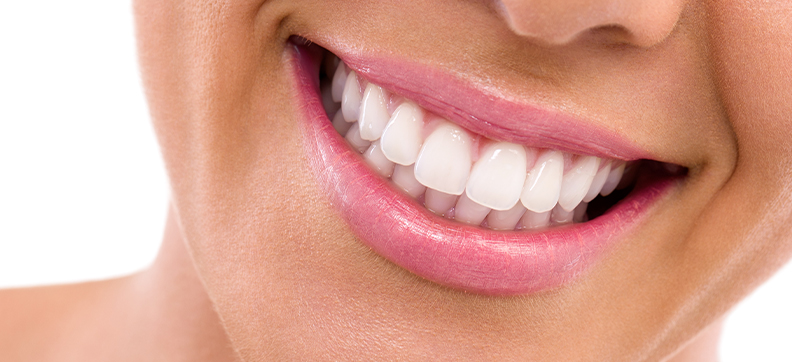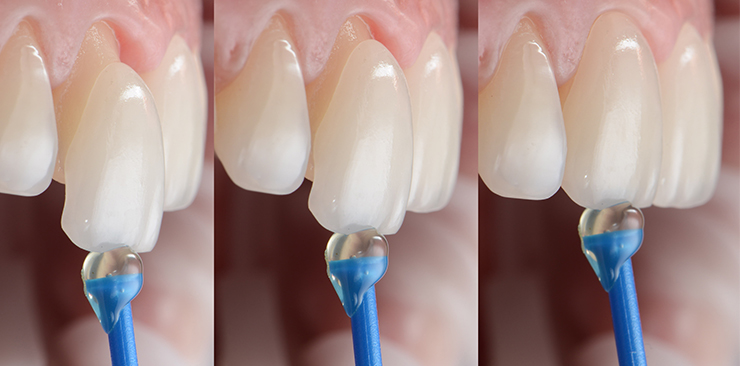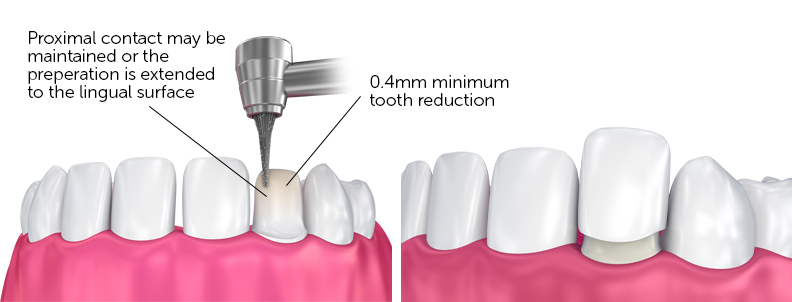In much the same way a false fingernail fits over a natural fingernail, a laminate veneer is a thin layer of ceramic that fit precisely over the front of teeth. The procedure is very effective in treating minor imperfections including chips, cracks, stains, misalignments, and unevenness of teeth. When you have spacing or crowding issues, they can also be used to transform your smile.
Laminate Veneer Usage
The veneer can cover one tooth that is discoloured or chipped, or the entire smile line can be covered with veneers. One of the easiest ways to enhance the appearance of your smile is with veneers, which make your teeth look natural and healthy.
The use of veneers is generally not recommended for patients with large gaps between their teeth, broken teeth, very large fillings/cavities, overbite, or grinding problems.

What’s The Difference Between Veneers And Lumineers?

A particular brand of veneer is called Lumineer®. With Lumineers, local anesthesia is not required for drilling or injections because Cerinate® ceramic, the material Lumineers are composed of, is an ultra-thin material like contact lenses. Lumineers are commonly known as “no-prep” veneers.
It is less invasive to apply Lumineers to your teeth since they require less preparation. Compared to veneers, they have the potential to be reversible, but they do not last nearly as long. Compared to veneers, they have the potential to be reversible, but they do not last nearly as long. However, unlike conventional veneers, there is no need for temporary veneers to be fitted while you are waiting for your customised Lumineers

Laminate Veneer Benefits
- Only minimal preparation of your teeth is required for veneers. In order to ensure the veneer can bond properly a very small amount of enamel may be removed.
- It is challenging to tell the difference between your natural teeth and the veneer as veneers can be custom-made to match perfectly the size and colour of your natural teeth.
- Veneers resist stains
- Veneers are friendly to the gum
- Veneers have a life span of approximately 15-20 years before you may need to replace them
- Veneers don’t need drilling
- Maintenance of your teeth is easy, Veneers don’t need any extra maintenance. You simply brush your teeth as you would normally.
- Veneers can fix a discoloured tooth resulting from the root canal treatment, making your tooth have a similar shade to the adjacent tooth.
- For people seeking a perfect smile, Veneers are very popular as they are translucent and give your teeth a very natural look in flash photography or under fluorescent light

Laminate Veneer Procedure
Step-By-Step Procedure
1st Appointment
- Consultation and clinical examination to evaluate the X-Ray and to match the shade of the crown to your natural teeth
- A local anesthetic will be administered however this is not necessary for Lumineer®
- The tooth will be prepared by removing a small amount of tooth structure. However, for Lumineer® removing any tooth structure is not necessary.
- Using an intra-oral camera or the traditional mould filled with dental paste that you will be asked to bite into an impression of your tooth will be taken. The tooth impression will be sent to the dental laboratory where the veneer will be made.
- A temporary veneer will be fitted while you are waiting for your permanent veneer to be made. This is not necessary for Lumineer®. While you are waiting for your permanent veneer it is best to avoid sticky or hard food and to avoid chewing from that side.
2nd Appointment
- At this appointment, the fitting will be checked in terms of bite, size, shape, and colour. In some cases, if everything is ok the veneer can be polished and cemented at this second appointment
3rd Appointment
- Final checks and adjustments, polishing and fixing the veneer permanently, If required an extra one or two appointments may be needed for perfect fitting.
Frequently Asked Questions
How many veneers do I need?
Your Cosmetic Dentist needs to see the photos we request from you to determine how many veneers are required for your smile line. In general, it is a good idea to have an even number of veneers. Four, eight, ten, or twelve veneers give the best aesthetic results.
How do I care for my veneers?
Brushing two times each day for two minutes, flossing daily, and wearing a bite guard at night are great ways to protect the veneers. It is also beneficial to avoid eating very hard foods like almonds, or cracking shells with the front veneers.
Stop all bad teeth habits immediately following the fitting of your veneers, such as nail biting, straw chewing, fork nibbling, opening bags with teeth, pulling on clothing or gloves with teeth, and anything that will put undue stress on the veneers.
Can I eat comfortably with my veneers? Do they easily come off?
You might come across clinics claiming that you can’t eat comfortably with veneers as they easily come off and suggest crowns instead. We only recommend veneers to patients whose teeth are suitable for this type of restoration in the first place, including the exclusion of patients with over-bite or grinding issues. Then, we carefully select the material and the production technique for the veneer, options being Empress or CAD-CAM.
Even though, avoiding eating very hard foods like almonds are recommended to keep veneers safe, in general, you take care of your veneers more or less just as you do with your natural teeth.
What happens if one of my veneers comes off?
There is no need to panic. Sometimes this happens, although it’s rare. Please just make sure you don’t swallow it and keep it safe so that it is not lost or broken. Do not try to fix the problem yourself and do not use glue under any circumstances. You need to arrange a dental appointment to have it fixed in five minutes.
TAKE ADVANTAGE OF DENTAL SAVINGS IN 5 SIMPLE STEPS
Complete The Enquiry Form Below
Fields marked * are compulsory
[wpforms id=”797″]

